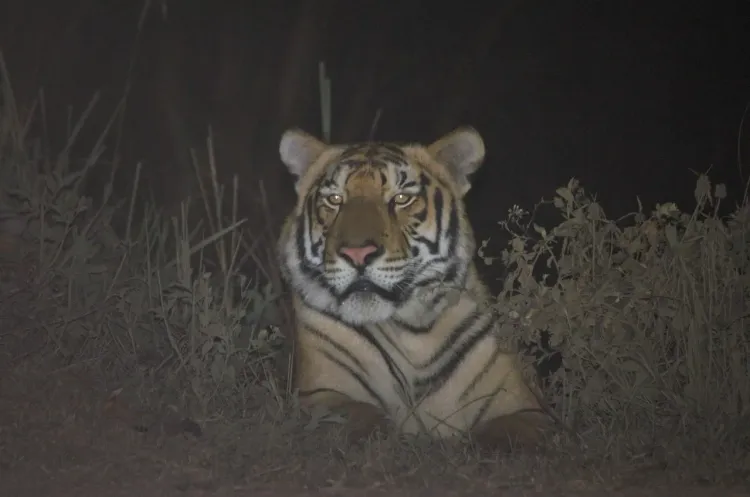Is Assam's Kaziranga Now the Third Highest in Tiger Density?

Synopsis
Key Takeaways
- Kaziranga ranks third globally in tiger density.
- Total of 148 adult tigers identified in 2024.
- Significant increase from 104 tigers in 2022.
- Advanced technology aids in monitoring and protection.
- Community involvement is critical for conservation efforts.
Guwahati, July 29 (NationPress) Kaziranga National Park and Tiger Reserve (KNPTR), which houses the Greater one-horned Rhinoceroses, now holds the impressive title of the third highest tiger density in the world, boasting 18 tigers per 100 sq km, as announced by officials on Tuesday.
KNPTR Director Sonali Ghosh revealed that according to the recent report titled "Status of Tigers in Kaziranga, 2024," a total of 148 adult tigers were recorded in the three divisions of Kaziranga Tiger Reserve (KTR), a significant rise from 104 in 2022.
Among these 148 tigers, there are 83 females, 55 males, and 10 of undetermined gender.
“This increase is particularly remarkable due to the initial sampling in the Biswanath Wildlife Division, where 27 tigers were documented, contributing to the overall growth. In the core Eastern Assam Wildlife Division, tiger numbers rose from 104 in 2022 to 115 in 2024, while the Nagaon Wildlife Division maintained a steady count of 6 tigers,” stated Ghosh.
The methodology utilized for the tiger census involved the implementation of remotely triggered camera traps, adhering to the Phase IV Protocol established by the National Tiger Conservation Authority (NTCA) and the Wildlife Institute of India.
A senior official from the Indian Forest Service (IFS) explained that paired camera traps were strategically placed across 1,307.49 sq km spanning the three divisions of Kaziranga Tiger Reserve from December 2023 to April 2024, using a structured grid design to ensure thorough spatial coverage.
Trap locations were meticulously chosen based on detailed sign surveys to maximize the likelihood of detecting tigers and their co-predators.
Assam Chief Minister Himanta Biswa Sarma, while announcing the tiger census results, expressed on social media: “From Kaziranga to Manas, Assam is not just focused on tiger protection but also plays a vital role in restoring the tiger's habitat. With the world’s third-highest tiger density, expansive forest cover, and decisive measures against infiltration, the tiger, which is a treasure of Assam's forests, is thriving today.”
Director Ghosh highlighted that the primary factors driving this positive increase in the tiger population are habitat expansion and protection.
Recently, an additional area of 200 sq km, including 12.82 sq km of encroachment-free land, has been integrated under the Burhachapori-Laokhowa sanctuaries in the Nagaon Wildlife Division, further increasing the protected habitats of the Tiger Reserve.
This strategic expansion has greatly broadened the landscape available for tigers, enhancing their opportunities for movement, breeding, and dispersal across divisions, she pointed out.
Moreover, the enhanced application of technology has transformed wildlife monitoring and conservation practices. Ghosh noted that along with camera traps, the use of drones and infrared-based surveillance systems, referred to as the "Electronic Eye," has become essential to daily operations.
As per the KNPTR Director, advancements in technology have significantly improved anti-poaching initiatives, movement tracking, and habitat monitoring, resulting in enhanced safety and better data collection.
Importantly, the combination of advanced technology and the dedicated efforts of frontline forest staff, including 113 trained ‘Van Durgas’, the female workforce of the Tiger Reserve, alongside the support from civil society organizations and local communities, has played a crucial role in bridging historical data gaps, she remarked.
In recent years, Kaziranga's tiger monitoring has yielded gender-specific data, providing a more precise and comprehensive understanding of the reserve’s tiger demographics.
Ghosh emphasized that the increase in the tiger population is more than just a numerical achievement; it reflects the overall health and robustness of the Kaziranga ecosystem, which sustains a diverse array of flora and fauna.
This flourishing tiger population stands as a testament to our successful conservation efforts.
“While we celebrate this significant milestone, we acknowledge the responsibility it entails. It is vital to persist in investing in conservation initiatives, fortifying community engagement, and fostering awareness about the importance of biodiversity,” stated the IFS official.










